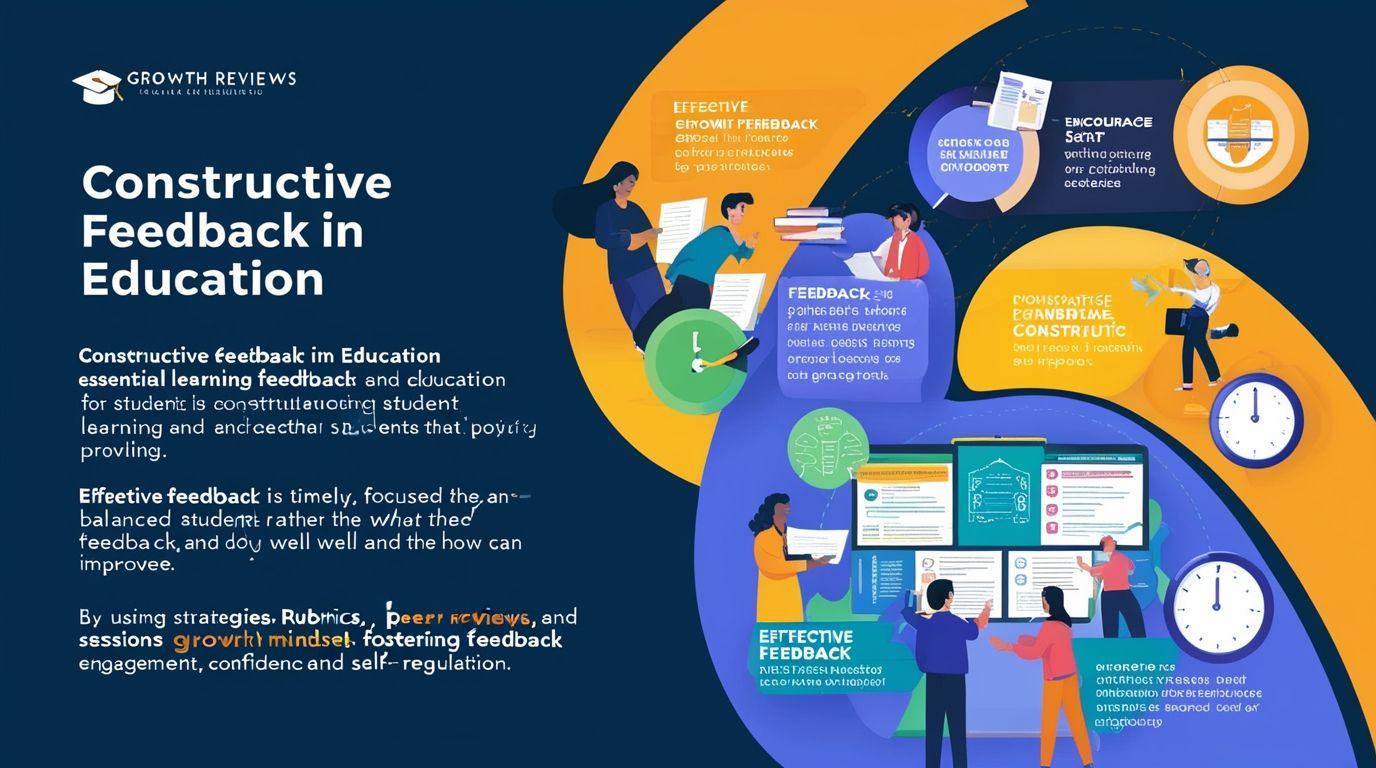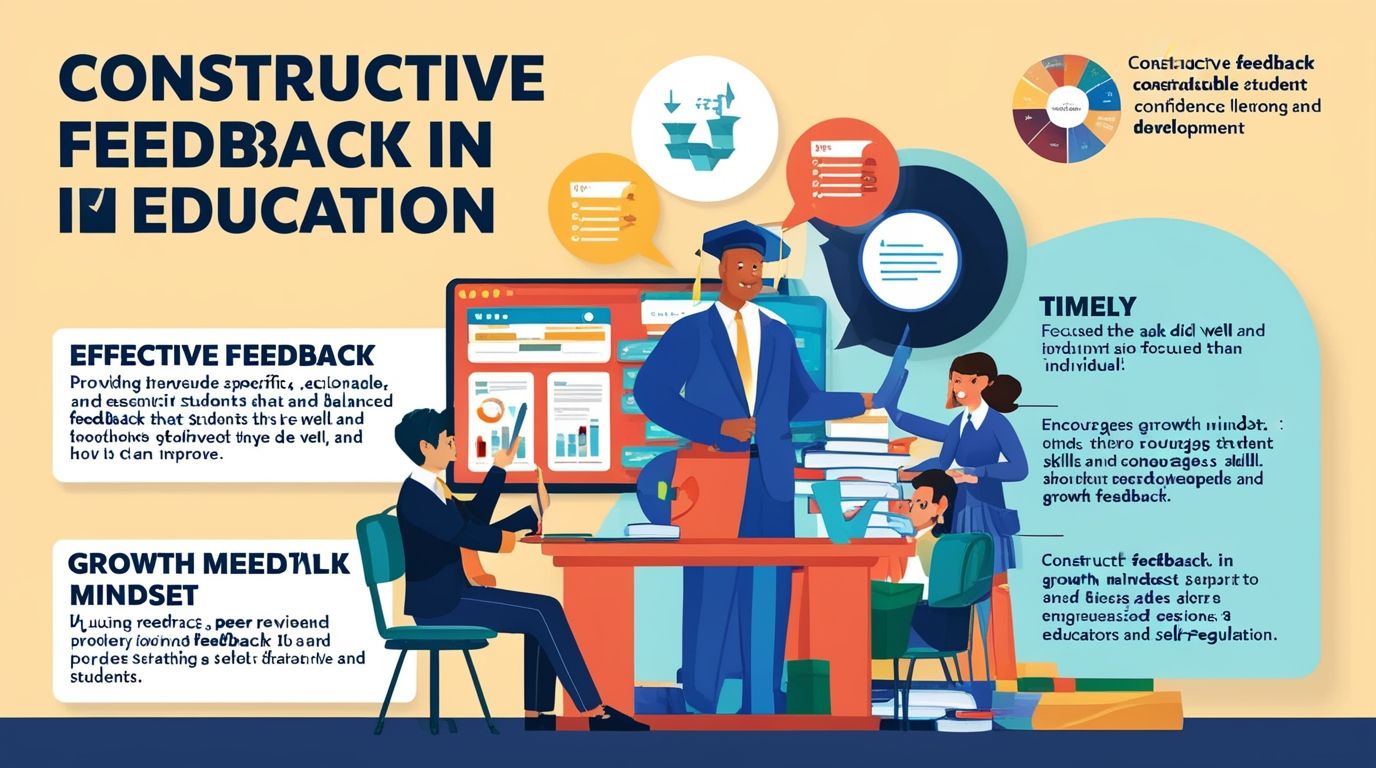Constructive Feedback in Education Feedback is a critical component of the educational process, serving as a bridge between teaching and learning. Constructive feedback, specifically, plays a pivotal role in helping students understand their strengths, identify areas for improvement, and develop their skills. This article explores the concept of constructive feedback, its importance in education, principles for effective feedback, and practical strategies for implementation.
Importance of Constructive Feedback
Constructive feedback is a form of communication that aims to improve the learner’s performance or understanding by providing specific, actionable, and positive information. It is essential in education for several reasons:
- Enhancing Learning Outcomes: Constructive feedback helps students understand the gap between their current performance and desired learning goals, which encourages them to take specific actions to close that gap (Hattie & Timperley, 2007).
- Promoting Student Engagement: Feedback that is constructive and supportive can boost student motivation and engagement by making learning more interactive and personalized (Brookhart, 2008).
- Developing Self-Regulation Skills: By receiving feedback that is focused on the learning process rather than the end result, students can develop self-regulation skills that help them manage their learning more effectively (Nicol & Macfarlane-Dick, 2006).
- Building Confidence: Constructive feedback emphasizes what students are doing right and provides clear suggestions for improvement, which can build confidence and foster a growth mindset (Dweck, 2006).
Principles of Effective Constructive Feedback
To maximize the impact of feedback in education, certain principles should be followed:
- Timeliness: Feedback should be provided promptly while the learning activity is still fresh in the student’s mind. Timely feedback helps students immediately apply what they have learned and correct mistakes early (Shute, 2008).
- Specificity: Feedback must be specific, focusing on particular aspects of the student’s work rather than general comments. Specific feedback allows students to understand exactly what needs improvement (Sadler, 1989).
- Actionability: Feedback should be actionable, meaning it should include clear guidance on how students can improve. Without actionable advice, feedback may be perceived as criticism rather than a helpful tool (Wiggins, 2012).
- Balance of Positive and Negative Comments: Constructive feedback should balance positive reinforcement with suggestions for improvement. This balance helps maintain student motivation and receptiveness (Hattie & Timperley, 2007).
- Focus on the Task, Not the Learner: Feedback should be centered on the task or the process rather than the student’s personal attributes. This approach avoids making the feedback personal, which can reduce defensiveness and increase receptiveness (Kluger & DeNisi, 1996).

Strategies for Implementing Constructive Feedback in the Classroom
Implementing effective constructive feedback in the classroom requires thoughtful strategies tailored to the needs of both students and teachers:
- Use of Rubrics and Clear Criteria: Providing students with rubrics or clear criteria for assignments helps them understand what is expected and allows feedback to be more specific and aligned with learning goals (Brookhart, 2013).
- Incorporating Peer Feedback: Encouraging students to give and receive feedback from peers can deepen their understanding of the subject matter and develop their evaluative skills. Peer feedback also diversifies the feedback sources, providing multiple perspectives (Topping, 1998).
- Feedback Sandwich Method: This method involves presenting feedback in a sequence: starting with positive feedback, followed by constructive criticism, and ending with additional positive reinforcement. This approach can make students more receptive to criticism by cushioning it with positive comments (Fredrickson, 2001).
- Use of Digital Tools: Digital platforms like Google Classroom, Turnitin, and others offer features that facilitate timely, specific, and actionable feedback. These tools allow teachers to provide feedback directly on assignments and can include multimedia elements to clarify feedback points (Nicol, 2010).
- Personalized Feedback Sessions: One-on-one feedback sessions can be more effective than written feedback because they allow for a dialogue between the teacher and student. In these sessions, students can ask questions and seek clarification, making the feedback more impactful (Hattie, 2012).
- Encouraging a Growth Mindset: Feedback should be framed in a way that encourages a growth mindset, focusing on the belief that abilities can be developed through effort and practice. This approach helps students view feedback as an opportunity for growth rather than a judgment of their abilities (Dweck, 2006).
- Reflective Practices: Encouraging students to reflect on the feedback they receive and set personal goals based on this feedback can deepen their engagement and commitment to improvement. Reflection activities can include journals, self-assessments, or goal-setting worksheets (Boud & Molloy, 2013).
- Consistency in Feedback: Consistent feedback practices help students know what to expect and how to interpret feedback. Consistency also builds trust, as students see feedback as a regular part of the learning process rather than occasional comments (Black & Wiliam, 1998).
Challenges in Providing Constructive Feedback
While the benefits of constructive feedback are clear, implementing it effectively can be challenging:
- Time Constraints: Teachers often face time constraints that make it difficult to provide detailed and timely feedback to all students. This challenge can be addressed through the use of technology and streamlined feedback practices (Carless, 2006).
- Student Receptiveness: Not all students are receptive to feedback, especially if they have had negative experiences in the past. Teachers must work to create a classroom environment that values feedback as a learning tool (Irons, 2008).
- Balancing Quantity and Quality: Too much feedback can overwhelm students, while too little may not provide sufficient guidance. Finding the right balance is crucial for effective feedback (Gibbs & Simpson, 2004).
- Cultural Differences: Feedback practices that work well in one cultural context may not be as effective in another. Teachers need to be aware of cultural sensitivities and adapt their feedback strategies accordingly (Hyland & Hyland, 2006).
Conclusion
Constructive feedback is a powerful tool in education that, when used effectively, can significantly enhance learning outcomes, engagement, and student confidence. By adhering to principles such as timeliness, specificity, and actionability, and by employing strategies like the use of rubrics, peer feedback, and digital tools, educators can provide feedback that truly supports student growth. Despite the challenges, the positive impact of constructive feedback makes it an indispensable element of effective teaching and learning.
References
- Black, P., & Wiliam, D. (1998). Assessment and Classroom Learning. Assessment in Education: Principles, Policy & Practice, 5(1), 7-74.
- Boud, D., & Molloy, E. (2013). Feedback in Higher and Professional Education: Understanding It and Doing It Well. Routledge.
- Brookhart, S. M. (2008). How to Give Effective Feedback to Your Students. ASCD.
- Carless, D. (2006). Differing Perceptions in the Feedback Process. Studies in Higher Education, 31(2), 219-233.
- Dweck, C. S. (2006). Mindset: The New Psychology of Success. Random House.
- Hattie, J., & Timperley, H. (2007). The Power of Feedback. Review of Educational Research, 77(1), 81-112.
- Nicol, D. J., & Macfarlane-Dick, D. (2006). Formative Assessment and Self-Regulated Learning: A Model and Seven Principles of Good Feedback Practice. Studies in Higher Education, 31(2), 199-218.
- Shute, V. J. (2008). Focus on Formative Feedback. Review of Educational Research, 78(1), 153-189.
- Wiggins, G. (2012). Seven Keys to Effective Feedback. Educational Leadership, 70(1), 10-16.

7 thoughts on “Constructive Feedback in Education”
Comments are closed.